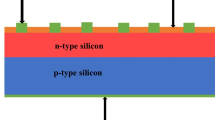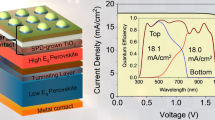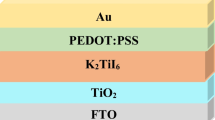Abstract
In this contribution, Automat FOR Simulation of HETero-structures v2.5 software was used for unveiling the photovoltaic performance and thermal stability of relatively less explored TiO2/c-Si heterojunction solar cell architecture based on 110 μm wafers. Firstly, the dependence of the photovoltaic performance on the emitter layer, i.e. the TiO2 layer, was explored by varying its different characteristics: thickness, carrier concentration and the defect density at the TiO2/Si interface. The study revealed that the power conversion efficiency might be as high as 16.34% (even without any interfacial passivation layer) even when the thickness of the wafer was kept at 110 μm; the thickness and the do** concentration of the TiO2 emitter layer were kept as 7 nm and 1 × 1020 cm−3; respectively. The corresponding defect density at the TiO2/p-Si interface was 1 × 1012 cm−2. Furthermore, a significant gain in the power output was realized by embedding either poly-silicon on oxide or carrier selective contact layer at the rear side of the device architecture. In the case of the incorporation of poly-silicon on the oxide structure at the rear side of the metal/c-Si interface, the role of the ultra-thin tunnel oxide thickness on the device's performance was explored in detail. Next, the poly-silicon on oxide structure was replaced by the NiOx layer, an efficient hole transport layer at the rear side of the device architecture. Various performance-affecting parameters, such as NiOx thickness, NiOx band gap, and the defect density at the NiOx/Si interface, were varied at different carrier concentrations of the NiOx layer to obtain the best possible conditions for realizing the maximum power output. The study was further extended to examine the influence of the wafer lifetime on the device performance of all the simulated solar cells. Eventually, the device temperature was varied from 275 to 375 K with an interval of 25 K to investigate the thermal stability of the proposed cell architectures so that the best possible architecture could be selected for practical fabrication both in terms of photovoltaic performance and thermal stability.
Similar content being viewed by others
Data Availability
No datasets were generated or analysed during the current study.
References
IEA: More than a third of the world’s electricity will come from renewables in 2025. March, 16, 2023, World Economic Forum. https://www.weforum.org/agenda/2023/03/electricity-generation-renewables-power-iea/
Chapin DM, Fuller CS, Pearson GL (1954) A new silicon p-n junction photocell for converting solar radiation into electric power. J Appl Phys 25:676–677. https://doi.org/10.1063/1.1721711
Srivastava V, Chauhan RK, Lohia P (2023) Investigating the performance of lead-free perovskite solar cells using various hole transport material by numerical simulation. Trans Electr Electron Mater 24:20–30. https://doi.org/10.1007/s42341-022-00412-w
Srivastava V, Chauhan RK, Lohia P (2023) Theoretical study of a lead-free perovskite solar cell using ZnSe as ETL and PTAA as HTL. Emerg Mater Res 12(1):37–46. https://doi.org/10.1680/jemmr.22.00059
Srivastava V, Chauhan RK, Lohia P (2022) Highly efficient cesium-based halide perovskite solar cell using SCAPS-1D software: Theoretical study. J Opt 52:1218–1225
Srivastava V, Chauhan RK, Lohia P, Yadav S (2023) Achieving above 25 % efficiency from FA0.85Cs0.15Pb(I0.85Br 0.15)3 perovskite solar cell through harnessing the potential of absorber and charge transport layers. Micro Nanostruct 184:207691. https://doi.org/10.1016/j.micrna.2023.207691
Mishra K, Chauhan RK, Mishra R (2023) Performance optimization of lead-free inorganic perovskite solar cell using SCAPS-1D. J Opt. https://doi.org/10.1007/s12596-023-01466-6
Chaudhary AK, Verma S, Chauhan RK (2023) Design of a low-cost, environment friendly perovskite solar cell with synergic effect of graphene oxide-based HTL and CH3NH3GeI3 as ETL. Eng Res Express IOP 5(3):035039. https://doi.org/10.1088/2631-8695/acee45
Srivastava V, Chauhan RK, Lohia P (2024) Investigation of Eco-friendly Perovskite Solar Cell Employing Niobium Pentoxide as Electron Transport Material using SCAPS-1D. Trans Electr Electron Mater. https://doi.org/10.1007/s42341-024-00509-4
Liu J, Yao Y, **ao S, Gu X (2018) Review of status developments of high-efficiency crystalline silicon solar cells. J Phys D Appl Phys 51(12):123001. https://doi.org/10.1088/1361-6463/aaac6d
Chistiakova G, Macco B, Korte L (2020) Low-temperature atomic layer deposited magnesium oxide as a passivating electron contact for c-si-based solar cells. IEEE J Photovolt 10(2):398–406. https://doi.org/10.1109/JPHOTOV.2019.2961603
Roy A, Benhaliliba M (2023) Investigation of ZnO/p-Si heterojunction solar cell: Showcasing experimental and simulation study. Optik 274:170557. https://doi.org/10.1016/j.ijleo.2023.170557
Chen L, Chen XL, Liu YM, Zhao Y, Zhang XD (2017) Research on ZnO/Si heterojunction solar cells. J Semicond 38(5):054005. https://doi.org/10.1088/1674-4926/38/5/054005
Naim H, Shah DK, Bouadi A (2022) An In-Depth Optimization of Thickness of Base and Emitter of ZnO/Si Heterojunction-Based Crystalline Silicon Solar Cell: A Simulation Method. J Electron Mater 51:586–593. https://doi.org/10.1007/s11664-021-09341-5
Hussain B, Aslam A, Khan TM, Creighton M, Zohuri B (2019) Electron Affinity and Bandgap Optimization of Zinc Oxide for Improved Performance of ZnO/Si Heterojunction Solar Cell Using PC1D Simulations. Electronics 8:238. https://doi.org/10.3390/electronics8020238
Nayak M, Mandal S, Pandey A, Mudgal S, Singh S, Komarala VK (2019) Nickel Oxide Hole-Selective Heterocontact for Silicon Solar Cells: Role of SiOx Interlayer on Device Performance. Solar RRL 3(11):1900261. https://doi.org/10.1002/solr.201900261
Islam MB, Yanagida M, Shirai Y, Nabetani Y, Miyano K (2017) NiOx Hole Transport Layer for Perovskite Solar Cells with Improved Stability and Reproducibility. ACS Omega 2(5):2291–2299. https://doi.org/10.1021/acsomega.7b00538
Battaglia C, de Nicolás SM, De Wolf S, Yin X, Zheng M, Ballif C, Javey A (2014) Silicon heterojunction solar cell with passivated hole selective MoOx contact. Appl Phys Lett 104:113902. https://doi.org/10.1063/1.4868880
Zhang T, Lee C-Y, Wan Y, Lim S, Hoex B (2018) Investigation of the thermal stability of MoOx as hole-selective contacts for Si solar cells. J Appl Phys 124:073106. https://doi.org/10.1063/1.5041774
Macco B, Black LE, Melskens J, van de Loo BWH, Berghuis W-JH, Verheijen MA, Kessels WMM (2018) Atomic-layer deposited Nb2O5 as transparent passivating electron contact for c-Si solar cells. Solar Energy Mater Solar Cells 184:98–104. https://doi.org/10.1016/j.solmat.2018.04.037
Ling X, Yuan J, Liu D, Wang Y, Zhang Y, Chen S, Wu H, ** F, Wu F, Shi G, Tang X, Zheng J, Liu SF, Liu Z, Ma W (2017) Room-temperature processed Nb2O5 as the electron-transporting layer for efficient planar perovskite solar cells. ACS Appl Mater Interfaces 9(27):23181–23188. https://doi.org/10.1021/acsami.7b05113
Yin X, Battaglia C, Lin Y, Chen K, Hettick M, Zheng M, Chen C-Y, Kiriya D, Javey A (2014) 19.2% Efficient InP Heterojunction Solar Cell with Electron-Selective TiO2 Contact. ACS Photonics 1(12):1245–1250. https://doi.org/10.1021/ph500153c
Yang X, Bi Q, Ali H, Davis K, Schoenfeld WV, Weber K (2016) High-performance TiO2-based electron-selective contacts for crystalline silicon solar cells. Adv Mater 28(28):5891–5897. https://doi.org/10.1002/adma.201600926
Lee C, Bae S, Park HJ, Choi D, Song H, Lee H, Ohshita Y, Kim D, Kang Y, Lee H-S (2020) Properties of thermally evaporated titanium dioxide as an electron-selective contact for silicon solar cells. Energies 13(3):678. https://doi.org/10.3390/en13030678
Hsu W, Sutter-Fella C, Hettick M (2015) Electron-selective TiO2 contact for Cu(In, Ga)Se2 solar cells. Sci Rep 5:16028. https://doi.org/10.1038/srep16028
Acharyya S, Sadhukhan S, Panda T, Ghosh DK, Mandal NC, Nandi A, Bose S, Das G, Maity S, Chaudhuri P, Saha H, Banerjee D (2022) Dopant-free materials for carrier-selective passivating contact solar cells: A review. Surf Interfaces 28:101687. https://doi.org/10.1016/j.surfin.2021.101687
Watanabe A, Qin G (2014) Heterojunctions of TiO2 nanoparticle film and c-Si with different Fermi level positions. Appl Phys A 116:1281–1285. https://doi.org/10.1007/s00339-014-8221-x
Samantaray MR, Gautam PK, Ghosh DS, Chander N (2021) Spray deposited TiO2 thin films for large-area TiO2/p-Si heterojunction solar cells. Eng Res Express 3(4):045053. https://doi.org/10.1088/2631-8695/ac41b6
Avasthi S, McClain WE, Man G, Kahn A, Schwartz J, Sturm JC (2013) Hole-blocking titanium-oxide/silicon heterojunction and its application to photovoltaics. Appl Phys Lett 102:203901. https://doi.org/10.1063/1.4803446
Yadav C, Kumar S (2022) Numerical simulation for optimization of ultra-thin n-type AZO and TiO2 based textured p-type c-Si heterojunction solar cells. Silicon 14:4291–4299. https://doi.org/10.1007/s12633-021-01212-2
International technology roadmap for photovoltaic (ITRPV), Fourteenth Edition, April 2023, VDMA, Germany
Ghosh DK, Bose S, Das G, Acharyya S, Nandi A, Mukhopadhyay S, Sengupta A (2022) Fundamentals, present status and future perspective of TOPCon solar cells: A comprehensive review. Surf Interfaces 30:101917. https://doi.org/10.1016/j.surfin.2022.101917
Varache R, Leendertz C, Gueunier-Farret ME, Haschke J, Muñoz D, Korte L (2015) Investigation of Selective Junctions Using a Newly Developed Tunnel Current Model for Solar Cell Applications. Sol Energy Mater Sol Cells 141:14–23. https://doi.org/10.1016/j.solmat.2015.05.014
Gorle DK, Chander N (2020) A simulation approach for device structure and thickness optimization of silicon heterojunction solar cells featuring TiO2 as carrier-selective contact. Mater Today Proc. https://doi.org/10.1016/j.matpr.2020.08.312
Ghosh DK, Acharyya S, Bose S, Das G, Mukhopadhyay S, Sengupta A (2023) A detailed theoretical analysis of TOPCon/TOPCore solar cells based on p-type wafers and prognosticating the device performance on thinner wafers and different working temperatures. Silicon 15:7593–7607. https://doi.org/10.1007/s12633-023-02606-0
Woods-Robinson R, Fioretti AN, Haschke J, Boccard M, Persson KA, Ballif C (2021) Evaluating materials design parameters of hole-selective contacts for silicon heterojunction solar cells. IEEE J Photovolt 11(2):247–258. https://doi.org/10.1109/JPHOTOV.2020.3038330
Zhang W, Shen H, Yin M, Lu L, Xu B, Li D (2022) Heterostructure silicon solar cells with enhanced power conversion efficiency based on SiOx/Ni3+ self-doped NiOx passivating contact (Supporting Information). ACS Omega 7(19):16494–16501. https://doi.org/10.1021/acsomega.2c00496
Polyanskiy MN (2024) Refractiveindex.info database of optical constants. Sci Data 11(94). https://doi.org/10.1038/s41597-023-02898-2
Glunz SW, Feldmann F (2018) SiO2 surface passivation layers – a key technology for silicon solar cells. Sol Energy Mater Sol Cells 185:260–269. https://doi.org/10.1016/j.solmat.2018.04.029
Ge J, Ling ZP, Wong J, Mueller T, Aberle AG (2012) Optimisation of intrinsic a-Si: H passivation layers in crystalline-amorphous silicon heterojunction solar cells. Energy Procedia 15:107–117. https://doi.org/10.1016/j.egypro.2012.02.013
Acknowledgements
The present work has been carried out in DST-IIEST Solar PV Hub and supported by Department of Science and Technology (DST/TMD/SERI/HUB/2(G), Govt. of India (GoI). One of the authors, Dibyendu Kumar Ghosh is grateful to Ministry of New and Renewable Energy (MNRE), India for providing him the fellowship for conducting the research work.
Funding
The present work has been carried out in DST-IIEST Solar PV Hub and supported by Department of Science and Technology (DST/TMD/SERI/HUB/2(G), Govt. of India (GoI).
Author information
Authors and Affiliations
Contributions
Dibyendu Kumar Ghosh (Simulation and Analysis,Preparing Manuscript), Shiladitya Acharyya (Analysis), Sukanta Bose (Preparing Manuscript), Gourab Das (Conceptualizing and Proof), Sumita Mukhopadhyay (Supervising), Anindita Sengupta (Supervising). All authors read and approved the final manuscript.
Corresponding author
Ethics declarations
Ethics Approval
NA.
Consent to Participate
NA.
Consent for Publication
NA.
Competing Interests
The authors declare no competing interests.
Additional information
Publisher's Note
Springer Nature remains neutral with regard to jurisdictional claims in published maps and institutional affiliations.
Rights and permissions
Springer Nature or its licensor (e.g. a society or other partner) holds exclusive rights to this article under a publishing agreement with the author(s) or other rightsholder(s); author self-archiving of the accepted manuscript version of this article is solely governed by the terms of such publishing agreement and applicable law.
About this article
Cite this article
Ghosh, D.K., Acharyya, S., Bose, S. et al. Analysis of Advanced TiO2/Si based Solar Cell Architecture: Improving PV Parameters and Thermal Stability. Silicon (2024). https://doi.org/10.1007/s12633-024-03063-z
Received:
Accepted:
Published:
DOI: https://doi.org/10.1007/s12633-024-03063-z




